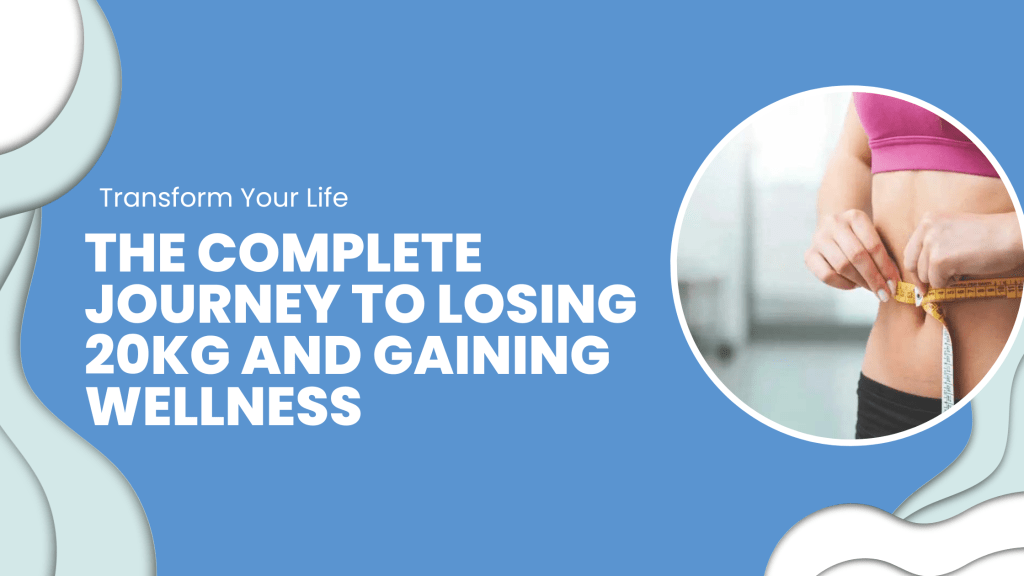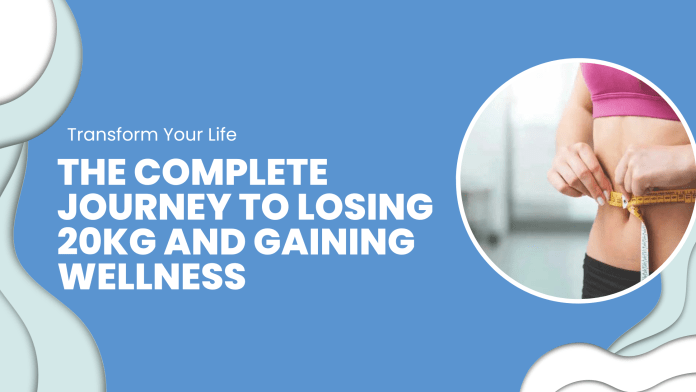Embarking on a weight loss journey to shed 20kg can be incredibly rewarding. This comprehensive guide provides in-depth strategies for safe, sustainable fat loss to help you achieve your goals and improve your health.
Before diving into specific dieting and exercise protocols, first establish the right mindset and reasonable expectations.
Understanding the Importance of Sustainable Weight Loss
The most effective weight loss happens steadily over time through incremental changes, not extreme rapid weight loss. Aim to lose about 0.5-1kg per week maximum for optimal fat burning without muscle loss or metabolic issues. More aggressive deficits are difficult to sustain long-term.
Know more about Mastering Domain Redirection: A Step-by-Step Guide with Hostinger.
Setting Realistic Goals for Your Transformation
Rather than fixating on the 20kg finish line, set mini goals like losing 2-4kg per month. Celebrate small milestones along the way like hitting 10% of your goal or fitting into a smaller clothing size. Expect ups and downs – weight loss is never linear. Stay patient and keep the big picture in mind.
Nutrition for Effective Weight Loss
Strategically managing your dietary intake will significantly accelerate your fat burning and weight loss results.

The Role of Calories: Creating a Caloric Deficit
To lose weight, you must burn more calories than you consume. A moderate daily calorie deficit of about 500 calories typically leads to about 0.5kg of fat loss per week. Calorie counting apps help monitor intake while meal planning.
Building a Balanced Plate: Macros and Micros
Emphasize lean proteins, fiber-rich complex carbohydrates, and healthy fats in each meal while limiting added sugars. Also ensure sufficient intake of vitamins, minerals and antioxidants through fruits, vegetables and supplements as needed.
Embracing Whole Foods: Incorporating Nutrient-Dense Choices
Minimally processed whole foods like fruits, vegetables, lean proteins, whole grains, nuts, seeds and legumes provide maximum nutrients to support your health and metabolism. Avoid empty calorie processed foods.
Portion Control: Mastering the Art of Mindful Eating
Practice mindful eating by listening to internal satiety signals, chewing thoroughly, minimizing distractions, and using smaller plates. Serve appropriate portions to avoid overconsumption while still feeling satisfied.
Crafting a Tailored Meal Plan
Carefully planning out your meals and snacks for the week leads to better execution and consistency with your nutrition strategy.
Designing a Personalized Eating Strategy
Factor your food preferences, cooking skills, schedule, and macro/calorie needs into designing a customized meal plan that optimizes nutrition while accommodating your lifestyle.
Meal Prepping: Your Key to Consistency and Convenience
Prepare several days worth of meals and snacks on your day off so you have pre-portioned, grab-and-go options available all week. Meal prepping streamlines healthy eating.
Sample Meal Plan for a Day: Breakfast, Lunch, Dinner, Snacks
Breakfast: Overnight oats with Greek yogurt, chia seeds and berries
Lunch: Grilled chicken breast with sweet potato and salad
Dinner: Veggie stir fry with tofu over brown rice
Snacks: Hummus with carrots and bell pepper, apple with natural peanut butter
Supercharging Your Workouts
Strategic, properly programmed exercise will accelerate calorie burning while preserving metabolism-boosting muscle.
Customizing Your Exercise Routine to Boost Metabolism
For maximum metabolic impact, blend strength training to build muscle, cardiovascular training to burn calories, and HIIT to torch fat. Periodize your training for continual progress.
Cardiovascular Workouts: Burning Calories and Improving Fitness
Aim for 150-300 minutes weekly of moderate intensity cardio such as brisk walking, jogging, cycling, swimming, dance, etc. Choose activities you enjoy and mix it up.
Strength Training: Sculpting Muscles and Enhancing Fat Loss
Lift weights 2-3x per week focusing on multi-joint, compound exercises like squats, deadlifts, presses, rows, and pulls. This preserves muscle mass which keeps metabolism revving.
The Benefits of Incorporating HIIT (High-Intensity Interval Training)
Just 20-30 minutes of HIIT 2-3x weekly consisting of short, intense intervals with rest can torch serious calories and elevate your post-exercise calorie burn. It’s an efficient fat blaster.
Lifestyle Changes for Long-Term Success
Certain holistic lifestyle habits dramatically impact weight loss success. Be sure to address these areas:
Prioritizing Sleep: The Connection Between Sleep and Weight Loss
Aim for 7-9 hours of quality sleep per night. Good sleep regulates appetite and hunger hormones, reduces cortisol, and allows the body to effectively metabolize fat and recover from exercise.
Stress Management: Cortisol’s Impact on Weight Gain
Chronic stress elevates cortisol hormones which can increase belly fat storage. Try meditation, yoga, nature walks, breathwork, massage and other relaxing activities to keep cortisol in check.
Hydration: Drinking Water for Weight Loss and Overall Health
Drink at least 2 liters of pure water daily to support metabolism, appetite regulation, exercise performance and health. Dehydration can disguise itself as hunger.
Mindful Eating: Techniques to Prevent Overeating and Cravings
Eat slowly without distractions, tune into your food’s textures and flavors, pause between bites, and listen to internal satiety signals to enhance satisfaction and fullness from meals.
Monitoring Progress and Adjusting Strategies
Ongoing objective tracking allows timely adjustments to your plan as needed.
Tracking Your Weight Loss Journey: Using Measurements and Photos
Weigh yourself weekly under consistent conditions and record it. Also, take monthly progress photos and body measurements with a tape measure for a big picture view.
Evaluating Plateaus: Strategies to Break Through Weight Loss Plateaus
Fat loss plateaus are normal. Reassess your calorie intake, increase activity levels, reduce sodium, drink more water and wait it out for 1-2 weeks before making major changes. Breakthroughs happen with patience.
Adapting Your Plan: How to Adjust Your Diet and Exercise as Needed
Make small incremental tweaks to your calories, macros or types of exercise if fat loss stalls for over a week. Experiment to find what works best for your unique body.
Psychological and Emotional Aspects
Cultivating a body-positive mindset and supportive environment dramatically boosts sustainable success.
Cultivating a Positive Body Image and Self-Love
Practice self-acceptance, self-care, gratitude for what your body allows you to experience, and speaking kindly to yourself. Don’t tie self-worth to the number on the scale.
Overcoming Emotional Eating: Coping Strategies and Mindset Shifts
Identify triggers, process emotions constructively through journaling or therapy, establish healthier habits, and foster a growth mindset. End using food as merely comfort.
Seeking Support: The Role of Friends, Family, and Professionals
Share your journey with a supportive community. Consider working with a registered dietitian, personal trainer, or therapist specialized in promoting a healthy relationship with food and body.
Sustaining Weight Loss
Thoughtfully transitioning into maintenance mode helps solidify your hard work for the long haul.
Transitioning from Weight Loss Phase to Maintenance
As you near your goal weight, gradually increase daily calories by about 50-100 while keeping activity levels high. This identifies your new maintenance intake.
Creating a Balanced and Enjoyable Lifestyle After Reaching Your Goal
Adopt a flexible, 80/20 approach with focus on whole foods and activities you enjoy to sustain weight without feeling deprived. Life should be about balance and fulfillment.
Summary and Key Takeaways
In summary, safe fat loss requires:
Recap of Essential Steps on the Weight Loss Journey
- Set mini goals and celebrate small milestones
- Dial in nutrition through calorie tracking and meal prepping
- Incorporate diverse metabolism-boosting exercise
- Address lifestyle factors like sleep, stress and mindfulness
- Monitor progress objectively and adjust your plan as needed
- Cultivate self-love and a constructive mindset
Emphasizing the Importance of Consistency and Patience
Stay patient through plateaus by trusting the process. Metabolic adaptation takes time. Small consistent efforts compound over months into huge results. Progress is not always linear.
How Can I Stay Motivated Throughout the Journey?
Celebrate milestones, find accountability partners, connect with online weight loss communities, focus on how you feel vs. the scale, and remind yourself of the big “why” behind your goals. Your motivation will ebb and flow.
Is It Necessary to Count Calories for Successful Weight Loss?
Tracking calories and macros provides accountability, but it’s not mandatory. Without tracking, emphasize high volume, low calorie density whole foods and listen to your hunger cues. High nutrition quality supports satiation.
What Should I Do If I Hit a Weight Loss Plateau?
Firstly, understand plateaus are normal. Re-evaluate your caloric intake, add more activity variety, reduce sodium, drink more water and wait it out for 1-2 weeks. Breakthroughs happen with patience.
Can I Indulge in Treats Occasionally and Still Lose Weight?
Absolutely. An 80/20 approach with focus on whole foods while allowing wiggle room enables balance. Build in small treats in moderation without guilt. Just account for them in your overall calorie budget.
How Quickly Can I Expect to Lose 20kg in a Healthy Manner?
Aim for steady fat loss of 0.5-1kg per week. For most, losing 20kg sustainably will likely take 16-32 weeks, or 4 to 8 months of consistent effort. Be patient and let your body adapt at its pace.

